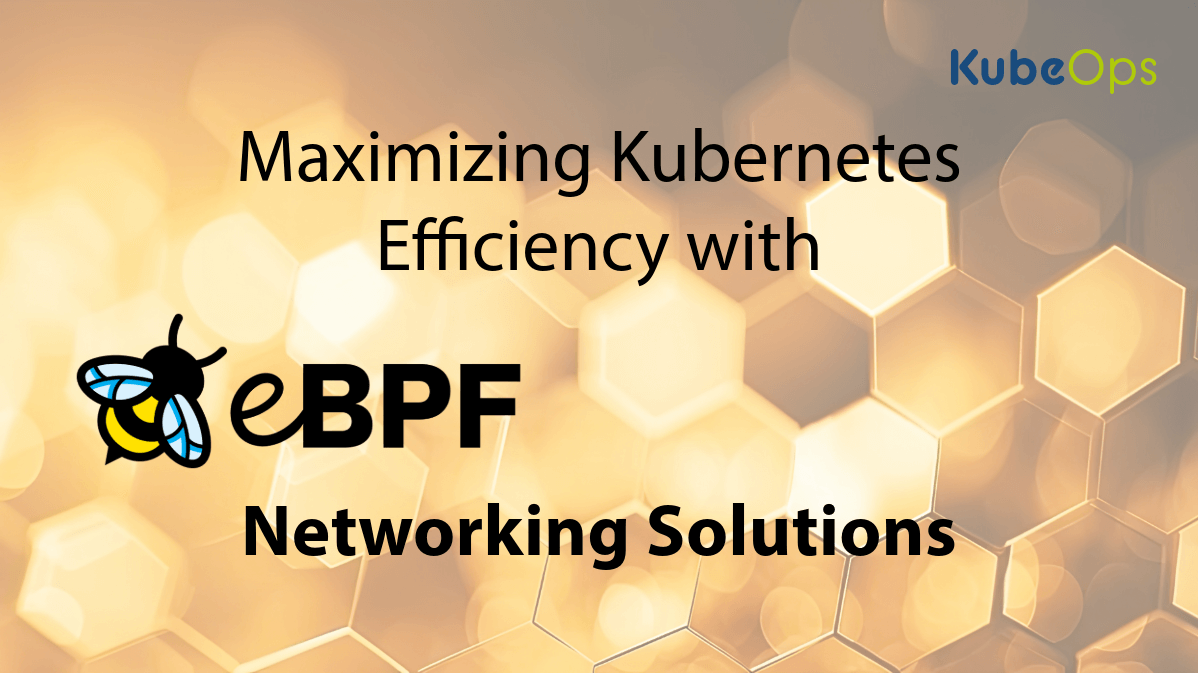Blogs
Maximizing Kubernetes Efficiency with eBPF Networking Solutions

The rise of Kubernetes as the go-to orchestration platform for containerized applications has brought many challenges, particularly in the realm of networking. Efficient network monitoring, security, and policy enforcement are critical for maintaining the performance and integrity of a Kubernetes cluster. Extended Berkeley Packet Filter (eBPF) has emerged as a powerful tool in addressing these challenges by enabling high-performance networking solutions that are both flexible and secure. This blog post delves into how eBPF is being used to revolutionize Kubernetes networking.
Understanding eBPF

eBPF is a revolutionary technology that allows code to run in the Linux kernel without changing the kernel source code or loading kernel modules. Originally designed for the dynamic tracing of Linux kernel code, eBPF has evolved to provide functionalities that include security, networking, and performance monitoring. The real power of eBPF lies in its high performance and the safety mechanisms that prevent unauthorized access or crashes in the kernel.
eBPF in Kubernetes Networking: Detailed Applications and Examples
eBPF (Extended Berkeley Packet Filter) plays a transformative role in Kubernetes networking, providing tools that greatly enhance monitoring, security, and network policy enforcement. Here's a more detailed exploration of how eBPF is applied within Kubernetes environments, complete with practical examples.
1. Advanced Network Monitoring:
eBPF facilitates granular network monitoring, which is crucial for maintaining performance and identifying issues in real-time. For instance, eBPF can track packet flows at various OSI layers, enabling operators to visualize traffic flow in and out of a Kubernetes cluster. Tools like Pixie leverage eBPF to automatically capture metrics like HTTP/gRPC requests, database queries, and network statistics without modifying applications. This capability allows developers and operators to trace requests from start to finish across the stack, which is invaluable for debugging and performance monitoring.
Example: An eBPF program could be configured to log all HTTP requests to a particular service within a cluster, including metadata like request size, response status, and latency. This data can be used to build a comprehensive picture of service health and client interaction patterns.
2. Enhancing Security Measures:
eBPF enhances security by enforcing policies that are dynamically inserted into the Linux kernel, thereby enabling fine-grained control over packet processing. This is particularly useful for implementing Kubernetes network policies, which can dictate how pods communicate with each other and the outside world.
Example: Using Cilium, an eBPF-based networking solution, administrators can implement a Kubernetes network policy that isolates a specific set of pods, preventing them from making or receiving connections to other pods except those explicitly allowed by the policy. Cilium translates these high-level policies into eBPF programs loaded into the Linux kernel, where they are enforced with minimal overhead.
3. Efficient Policy Enforcement:
Traditional Kubernetes networking relies heavily on iptables, which can become inefficient in large-scale environments due to the complexity and size of rule sets. eBPF offers a more scalable solution by shifting this functionality into the kernel space, using eBPF programs to make decisions about where to route traffic and whether to allow it.
Example: Imagine a scenario where you need to apply rate limiting to a service that receives a high volume of requests. With eBPF, you can write a program that counts the requests coming into the service and drops packets that exceed the threshold, directly within the kernel. This method is much faster and more resource-efficient compared to handling this at the application layer or via external tools.
4. Traffic Management and Load Balancing:
eBPF can be used to implement sophisticated traffic management strategies, such as canary deployments and blue-green deployments. By manipulating packet destinations at the kernel level, eBPF enables precise control over which users or sessions are routed to new service versions.
Example: For a canary deployment, an eBPF program can redirect a small percentage of user traffic to a new version of a service based on session data or user identifiers. This allows teams to test new features under real conditions without impacting the majority of users.
Tools and Implementations Leveraging eBPF in Kubernetes
The utilization of eBPF in Kubernetes networking has been bolstered by a variety of robust tools and projects that harness its capabilities for enhanced network monitoring, security, and policy enforcement:
1. Cilium: Perhaps the most prominent eBPF-based networking tool, Cilium provides network security and observability for container environments. It replaces traditional Linux networking and security mechanisms such as iptables with eBPF, enhancing both performance and scalability. Cilium enables fine-grained access control between microservices, visibility into L3/L4 and L7 traffic, and security based on identity rather than IP addresses.

2. Falco: Developed by Sysdig, Falco utilizes eBPF to monitor behavior at runtime and detect anomalous activities within containers. It's particularly useful for security enforcement, providing deep insights by capturing syscall data through eBPF, which is then analyzed against a set of rules to detect malicious activities.

3. BCC (BPF Compiler Collection): BCC is a toolkit for creating efficient kernel tracing and manipulation programs using eBPF. It includes several useful command-line tools and libraries to facilitate the development of custom eBPF programs. It's widely used for both performance monitoring and network tracing in Kubernetes environments.
4. Weave Scope: While not exclusively based on eBPF, Weave Scope can leverage eBPF to provide a more powerful and accurate method of generating container topology graphs and monitoring container processes in real-time.
Challenges and Considerations with eBPF in Kubernetes
Despite the powerful capabilities of eBPF, its integration into Kubernetes environments is not devoid of challenges:
1. Complexity of Development: Writing eBPF programs requires a deep understanding of Linux kernel internals, making it complex and challenging. The development of these programs typically requires expertise that may not be readily available in many organizations.
2. Debugging Difficulties: Debugging eBPF programs can be technically challenging. The tools and techniques for debugging are still maturing, and since eBPF operates at the kernel level, traditional debugging tools may not be effective.
3. Kernel Version Dependencies: eBPF's functionalities are dependent on the Linux kernel version. Different kernel versions support different eBPF features, which can lead to compatibility issues when deploying applications across diverse environments or when trying to use the latest eBPF features.
4. Security Implications: While eBPF is designed with several built-in security features, improper implementation can introduce risks. For instance, poorly designed eBPF programs have the potential to impact system performance or stability. Ensuring that eBPF programs are thoroughly audited and tested is crucial.
5. Performance Overheads: Although eBPF is designed to be highly efficient, certain types of eBPF programs can still introduce performance overheads if not properly optimized. Monitoring the impact of these programs on system performance is essential to avoid degrading the performance of the Kubernetes nodes.
Conclusion
eBPF is transforming Kubernetes networking by providing the tools needed to implement advanced monitoring, robust security, and efficient policy enforcement directly in the kernel. As Kubernetes environments continue to grow in size and complexity, eBPF’s role in enhancing network performance and security becomes increasingly vital. For organizations looking to harness the full potential of Kubernetes, integrating eBPF into their network architecture offers a path to achieving high-performance and highly secure networks.

